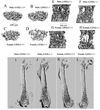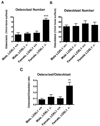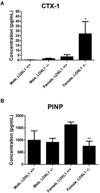Sex-Linked Skeletal Phenotype of Lysyl Oxidase Like-1 Mutant Mice
- PMID: 26538021
- PMCID: PMC8627178
- DOI: 10.1007/s00223-015-0076-4
Sex-Linked Skeletal Phenotype of Lysyl Oxidase Like-1 Mutant Mice
Abstract
Lysyl oxidases are required for collagen and elastin cross-linking and extracellular matrix maturation including in bone. The lysyl oxidase family consists of lysyl oxidase (LOX) and 4 isoforms (LOXL1-4). Here we investigate whether deletion of LOXL1, which has been linked primarily to elastin maturation, leads to skeletal abnormalities. Left femurs (n = 8), L5 vertebrae (n = 8), and tibiae (n = 8) were analyzed by micro-computed tomography in 13-week-old wild-type (WT) and LOXL1-/- male and female mice. Right femurs (n = 8) were subjected to immunohistochemistry for LOXL1, and histochemical/histology analyses of osteoclasts and growth plates. Sera from all mice were analyzed for bone turnover markers. Results indicate strong expression of LOXL1 in wild-type growth plates in femurs. Significant deterioration of trabecular bone structure in long bones and vertebrae from female was observed but not from male, mutant mice compared with WT. Decreases in BV/TV, Conn.D, trabecular thickness, and number in the femoral distal metaphysis were observed in female, but not in male, mutant mice. Trabecular spacing was increased significantly in femurs of female mutant mice. Findings were similar in trabeculae of L5 vertebrae from female mutant mice. The number of TRAP positive osteoclasts at the trabecular bone surface was increased in female mutant mice compared with WT females, consistent with increased serum RANKL and decreased OPG levels. Analysis of bone turnover markers confirmed increased bone resorption as indicated by significantly elevated CTX-1 in the serum of female LOXL1-/- mice compared to their wild-type counterparts, as well as decreased bone formation as measured by decreased serum levels of PINP. Picrosirius red staining revealed a loss of heterogeneity in collagen organization in female LOXL1-/- mice only, with little to no yellow and orange birefringence. Organization was also impaired in chondrocyte columns in both female and male LOXL1-/- mice, but to a greater extent in females. Data indicate that LOXL1-/- mutant mice develop appendicular and axial skeletal phenotypes characterized by decreased bone volume fraction and compromised trabecular microstructure, predominantly in females.
Keywords: Bone histomorphometry; Collagen; Genetic animal model; Lysyl oxidases; Micro-comuted tomography.
Conflict of interest statement
Conflicts of Interest
All authors declare no conflicts of interest.
Figures











References
-
- Csiszar K (2001) Lysyl oxidases: a novel multifunctional amine oxidase family. Progress in nucleic acid research and molecular biology 70:1–32 - PubMed
-
- Perryman L, Erler JT (2014) Lysyl oxidase in cancer research. Future Oncol 10:1709–1717 - PubMed
-
- Kenyon K, Contente S, Trackman PC, Tang J, Kagan HM, Friedman RM (1991) Lysyl oxidase and rrg messenger RNA. Science 253:802. - PubMed
-
- Liu G, Daneshgari F, Li M, Lin D, Lee U, Li T, Damaser MS (2007) Bladder and urethral function in pelvic organ prolapsed lysyl oxidase like-1 knockout mice. British Journal of Urology International 100:414–418 - PubMed
Publication types
MeSH terms
Substances
Grants and funding
LinkOut - more resources
Full Text Sources
Molecular Biology Databases

